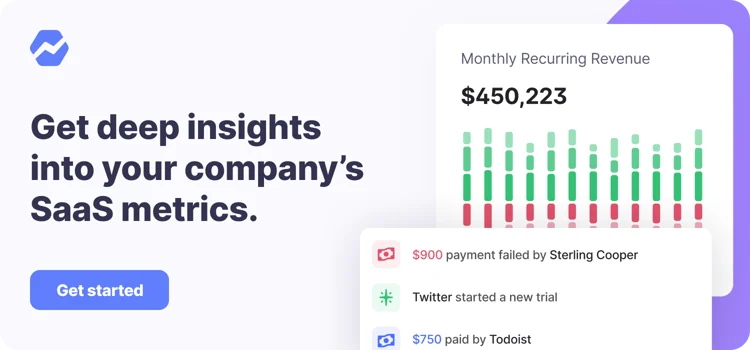Table of Contents

Before taking advantage of customer segmentation, you need to understand your customer base and what it wants before building new products and creating effective marketing campaigns.
You also need to know more about what it is and how you can use it to boost performance.
Customer segments should help you gain deeper insight into your current and potential customers so you can improve your marketing efforts and increase your conversions.
Learn more about the customer segmentation tool from Baremetrics. Sign up for a free trial of Baremetrics today!
What Is Customer Segmentation?
Customer segmentation puts people into categories based on characteristics they share. Segmenting doesn’t guarantee that your marketers will reach their target audience. However, it does help you create a more strategic approach.
The effectiveness of customer segmentation on marketing depends on how well you use customer data to craft marketing messages that get attention and increase your conversion rate.
Other benefits of a well-made marketing strategy built on top of carefully segmenting can include:
- Improving the customer journey and customer experience by giving them information that matters to each group’s unique needs.
- Increasing customer loyalty by targeting groups of customers with social media posts, emails, and other types of digital marketing.
- Helping your company make product development decisions that will attract first-time buyers.
- Optimizing e-commerce landing pages and product descriptions for different segments of your audience.
Baremetric’s segmentation feature lets you create custom segments on any dashboard so you can compare buyer personas, focus on specific personality traits, and highlight other consumer features.
You can also track growth through segments to determine expansion, reactivation, contraction, and churn rates.
Types of Market Segmentation
Customer segmentation models describe different aspects of individuals and groups. The following are some of the most important market segmentation models.
1. Behavioral Segmentation
Behavioral segmentation plays an essential role in e-commerce optimization because it tells you about a group’s:
- Internet browsing habits
- Brand loyalty
- Spending and purchasing habits
- Previous interactions with your brand
2. Demographic Segmentation
Demographic segmentation is perhaps the most obvious type of customer segmentation because it looks at characteristics like:
- Age
- Ethnicity
- Gender
- Education
- Income level
3. Geographic Segmentation
Geographic segmentation matters when you have regional stores or sell products that appeal to people living in certain areas. You can narrow geographic segmentation by:
- Country
- Region
- Metropolitan area
- City or town
- Postal code
4. Psychographic Segmentation
Psychographic segmentation looks at a customer’s personality traits, beliefs, and interests. It can include factors like:
- Religious beliefs
- Hobbies
- Lifestyle interests
- Values
5. Firmographic Segmentation
Firmographic segmentation appeals to B2B companies. Instead of using segmentation information to understand consumers, you use it to categorize and understand large clients. Firmographic segmentation can include characteristics like:
- Company size
- Industry
- Location
- Partnerships
Recommended reading:5 SaaS Analytics Tools to Track & Grow Your Business
Improve Your Marketing Strategy
Use Baremetrics to measure churn, LTV and other critical business metrics that help them retain more customers. Want to try it for yourself?
Examples of Customer Segmentation
Now that you have a deeper understanding of customer segmentation, let’s take a closer look at how you can use the features of specific groups to optimize your marketing and product development.
i. Occupation
Occupation can help you determine how to market a product to specific groups. For example, if you sell art supplies, you might use different marketing strategies to reach artists than you would use to reach kindergarten teachers.
The value proposition used to attract artists will likely emphasize the product’s quality, while campaigns aimed at kindergarten teachers speak to their goal of purchasing safe products at affordable prices.
ii. Family Size
Knowing the size of a person’s family can tell you a lot about what products and deals will attract their attention. For example, you might target large families with messaging about saving money with bulk orders.
A smaller family might not be interested in buying in bulk, but they could benefit from buy-one-get-one-free promotions that will help them save money.
iii. Gender
Depending on your product selection, you can often target customers by gender to increase sales. For example, if you sell makeup, you will likely get more interest from people who identify as female.
Marketing often uses gender stereotypes to generate interest among consumers. In some cases, it makes sense to target people by gender. Depending on what you sell, though, you may want to avoid this approach.
iv. Age
People tend to buy different products and services as they grow older. A video game developer might categorize customers by age to determine which games they advertise to specific people.
For example, a title that involves a lot of action and violence may be more appealing to young people. Older gamers might prefer games that let them play with friends remotely.
How you use customer segmentation will depend on your market research. Don’t assume you know what your target audience wants until you perform research that gives you more insight into their preferences.
Then, you can harness the power of customer segmentation to make your marketing plans more effective.
View a live demo to see how customer segmentation works in Baremetrics.
Improve Your Segmentation Strategy With Baremetrics
Make your product development and messaging more effective by targeting your market segment with help from Baremetrics.
Baremetrics can connect to any dashboard to comb through your data and organize customers into different groups.
Start a free, 14-day trial with Baremetrics today to see how straightforward your market segmentation strategy becomes when you have the right tool working for you.
Target Your Market Segment!
Get deep insights into your company’s MRR, churn and other vital metrics for your SaaS business.



